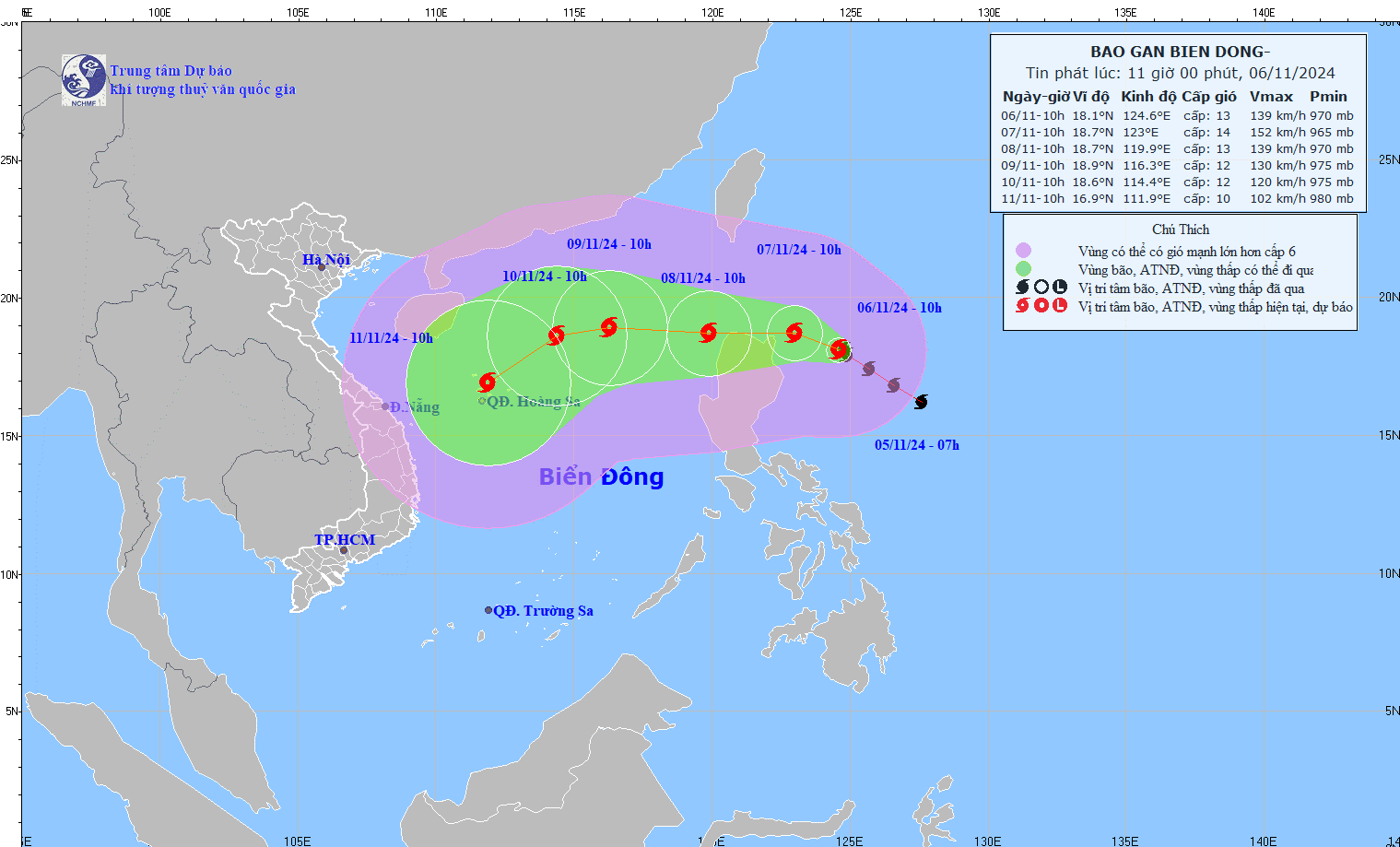Typhoon Yinxing is expected to enter the East Sea within the next two days, becoming the seventh storm of the season. Heavy rain zones in Central Vietnam are shifting southward and are expected to subside by November 8.
This afternoon (November 6), Vu Anh Tuan, Deputy Director of Weather Forecasting at the National Center for Hydro-Meteorological Forecasting, provided an update on Typhoon Yinxing (as of 11:00 AM) and the ongoing heavy rain in Central Vietnam.
According to Mr. Tuan, Typhoon Yinxing, a powerful storm, is currently situated over the northeastern waters off Luzon Island, Philippines. As of 10:00 AM, it had maximum sustained winds of 134-149 km/h near its center (Category 13), with gusts reaching Category 16, moving northwest at around 15 km/h.
“The latest update suggests that around November 8, the storm is likely to enter the eastern part of the northern East Sea, becoming the seventh storm of this year’s storm season,” said Mr. Tuan.
As Typhoon Yinxing moves into the northern East Sea, it is expected to have sustained winds of Category 12-13. Due to colder sea surface temperatures, changing atmospheric conditions, and the influence of a cold front, the storm’s intensity may fluctuate, especially as it approaches the northeastern Hoang Sa (Paracel) archipelago.
Forecasts indicate that from November 8-10, Yinxing will move northeast toward the northern Hoang Sa region before veering southwest toward the Hoang Sa area. Due to potential changes in the storm’s path and intensity, residents should follow further updates.
Yinxing is expected to generate strong winds in the eastern East Sea at Category 6-7, increasing to Category 8-10 from the evening of November 7. Areas near the storm’s center could see winds of Category 11-13, with gusts reaching Category 16, and waves between 4-8 meters, creating dangerous conditions for marine vessels.
The following day, the storm will change direction again, moving west-northwest at around 15 km/h. By 7:00 PM on November 9, Yinxing's center is forecasted to be in the northern East Sea, roughly 320 km northeast of the Hoang Sa Islands, weakening further to Category 12 with gusts up to Category 14.
In the period from 72 to 120 hours, the storm may alter its course once more, moving west-southwest at 10-15 km/h, with its intensity continuing to decrease.
Meteorologists expect that when Yinxing reaches the northern East Sea, it will encounter a cold front and lower sea surface temperatures, which will contribute to a weakening of the storm, especially as it moves into the northeastern waters of the Hoang Sa archipelago.
Shift of heavy rain zones in Central Vietnam
Mr. Vu Anh Tuan also noted that the heavy rain in Central Vietnam has shifted southward overnight, now affecting areas south of the Hai Van Pass due to easterly wind disturbances and the cold front moving south.
From Thua Thien-Hue to Binh Dinh, rainfall has ranged from 50-100 mm, with localized areas in Quang Nam, Quang Ngai, and northern Binh Dinh receiving over 200 mm. This rain belt is forecast to continue expanding southward toward Khanh Hoa through November 7, with potential rainfall reaching 50-100 mm in most areas and over 200 mm in certain locations.
Heavy rainfall may be concentrated in certain areas with up to 100 mm over six hours, raising concerns about flash floods, landslides on slopes, and urban flooding in low-lying regions.
Rainfall is expected to persist from Quang Nam to Khanh Hoa through November 7, with intermittent heavy downpours. In Quang Tri to Da Nang, rain levels will be lower, ranging from 30-80 mm. Heavy rainfall will gradually decrease by the night of November 7, with an end to heavy rain in Central Vietnam anticipated by November 8.
Additionally, areas in Ninh Thuan, Binh Thuan, the Central Highlands, and southern Vietnam will experience scattered showers and thunderstorms with rainfall ranging from 15-80 mm, with localized heavy downpours in the northern Central Highlands.
The meteorological agency warns that intense and localized heavy rain could lead to flooding in low-lying areas, flash floods on small rivers and streams, and landslides on slopes.
Bao Anh
